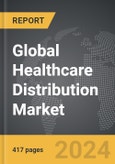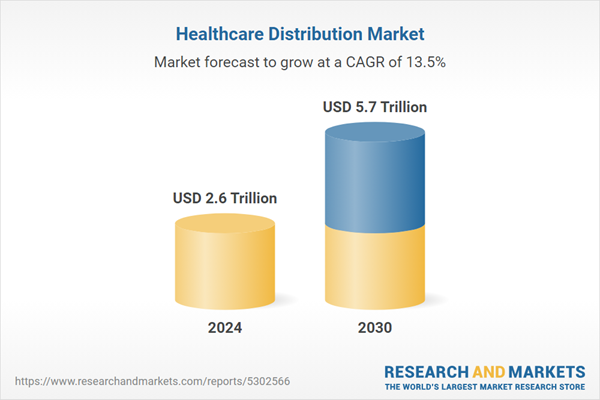Global Healthcare Distribution Market - Key Trends & Drivers Summarized
Healthcare distribution is a critical component of the medical supply chain, ensuring that pharmaceutical products, medical devices, and healthcare supplies are efficiently delivered from manufacturers to healthcare providers and patients. This complex network involves various stakeholders, including wholesalers, distributors, and logistics providers, who coordinate to maintain the integrity and availability of medical products. Healthcare distribution companies are responsible for the storage, handling, and transportation of these products, adhering to stringent regulations and standards to ensure product safety and efficacy. The sector encompasses a wide range of activities, from managing temperature-sensitive medications in cold chain logistics to ensuring timely delivery of life-saving drugs and equipment to hospitals and clinics. Effective healthcare distribution is essential for maintaining the continuous supply of critical medical products, particularly during emergencies and public health crises.The healthcare distribution industry has evolved significantly with advancements in technology and logistics management. The integration of track-and-trace technologies, such as RFID and blockchain, has improved the transparency and security of the supply chain, reducing the risk of counterfeit products entering the market. The rise of e-commerce and digital health platforms has also transformed healthcare distribution, enabling direct-to-patient delivery models and expanding access to healthcare products. These technological advancements not only streamline operations but also provide better visibility and control over the supply chain, ensuring that healthcare providers and patients receive their products safely and on time.
The growth in the healthcare distribution market is driven by several factors, including increasing demand for pharmaceutical products, advancements in logistics technology, and the expansion of the healthcare sector. The rising prevalence of chronic diseases and an aging population have led to higher consumption of medications and medical supplies, necessitating efficient distribution networks. Technological advancements, such as the implementation of artificial intelligence (AI) and machine learning in predictive analytics, have optimized supply chain operations, enhancing demand forecasting and inventory management. Additionally, the expansion of healthcare infrastructure in emerging markets has increased the need for robust distribution networks to support growing medical needs. The COVID-19 pandemic further underscored the importance of resilient healthcare distribution systems, as the rapid and widespread distribution of vaccines and medical supplies became a global priority. Moreover, regulatory pressures to ensure compliance and the growing trend of personalized medicine are also significant drivers, requiring tailored distribution solutions to meet specific patient needs. These factors collectively contribute to the robust expansion of the healthcare distribution market, ensuring its critical role in the global healthcare ecosystem.
Report Scope
The report analyzes the Healthcare Distribution market, presented in terms of market value (USD). The analysis covers the key segments and geographic regions outlined below.- Segments: Product Type (Pharmaceutical, Biopharmaceutical, Medical Devices); End-Use (Retail Pharmacies, Hospital Pharmacies, Other End Uses).
- Geographic Regions/Countries: World; USA; Canada; Japan; China; Europe; France; Germany; Italy; UK; Spain; Russia; Rest of Europe; Asia-Pacific; Australia; India; South Korea; Rest of Asia-Pacific; Latin America; Argentina; Brazil; Mexico; Rest of Latin America; Middle East; Iran; Israel; Saudi Arabia; UAE; Rest of Middle East; Africa.
Key Insights:
- Market Growth: Understand the significant growth trajectory of the Pharmaceutical Distribution segment, which is expected to reach US$2.3 Trillion by 2030 with a CAGR of 13.3%. The Biopharmaceutical Distribution segment is also set to grow at 14.8% CAGR over the analysis period.
- Regional Analysis: Gain insights into the U.S. market, valued at $914.1 Billion in 2024, and China, forecasted to grow at an impressive 15.6% CAGR to reach $1.0 Trillion by 2030. Discover growth trends in other key regions, including Japan, Canada, Germany, and the Asia-Pacific.
Why You Should Buy This Report:
- Detailed Market Analysis: Access a thorough analysis of the Global Healthcare Distribution Market, covering all major geographic regions and market segments.
- Competitive Insights: Get an overview of the competitive landscape, including the market presence of major players across different geographies.
- Future Trends and Drivers: Understand the key trends and drivers shaping the future of the Global Healthcare Distribution Market.
- Actionable Insights: Benefit from actionable insights that can help you identify new revenue opportunities and make strategic business decisions.
Key Questions Answered:
- How is the Global Healthcare Distribution Market expected to evolve by 2030?
- What are the main drivers and restraints affecting the market?
- Which market segments will grow the most over the forecast period?
- How will market shares for different regions and segments change by 2030?
- Who are the leading players in the market, and what are their prospects?
Report Features:
- Comprehensive Market Data: Independent analysis of annual sales and market forecasts in US$ Million from 2024 to 2030.
- In-Depth Regional Analysis: Detailed insights into key markets, including the U.S., China, Japan, Canada, Europe, Asia-Pacific, Latin America, Middle East, and Africa.
- Company Profiles: Coverage of players such as Cardinal Health, Inc., Epicor Software Corporation, Henry Schein, Inc., FedEx Corporation, Imperial Logistics Group (Pty) Limited and more.
- Complimentary Updates: Receive free report updates for one year to keep you informed of the latest market developments.
Some of the 61 companies featured in this Healthcare Distribution market report include:
- Cardinal Health, Inc.
- Epicor Software Corporation
- Henry Schein, Inc.
- FedEx Corporation
- Imperial Logistics Group (Pty) Limited
- HighJump Software, Inc.
- CenTrak, Inc.
- Biolog-id
- Express Scripts Holding Company
- AmerisourceBergen Corporation
- Global Healthcare Exchange LLC (Ghx)
- Alliance Healthcare
- Cavalier Logistics
- Intalere
- Hvantage Technologies Inc.
This edition integrates the latest global trade and economic shifts into comprehensive market analysis. Key updates include:
- Tariff and Trade Impact: Insights into global tariff negotiations across 180+ countries, with analysis of supply chain turbulence, sourcing disruptions, and geographic realignment. Special focus on 2025 as a pivotal year for trade tensions, including updated perspectives on the Trump-era tariffs.
- Adjusted Forecasts and Analytics: Revised global and regional market forecasts through 2030, incorporating tariff effects, economic uncertainty, and structural changes in globalization. Includes historical analysis from 2015 to 2023.
- Strategic Market Dynamics: Evaluation of revised market prospects, regional outlooks, and key economic indicators such as population and urbanization trends.
- Innovation & Technology Trends: Latest developments in product and process innovation, emerging technologies, and key industry drivers shaping the competitive landscape.
- Competitive Intelligence: Updated global market share estimates for 2025, competitive positioning of major players (Strong/Active/Niche/Trivial), and refined focus on leading global brands and core players.
- Expert Insight & Commentary: Strategic analysis from economists, trade experts, and domain specialists to contextualize market shifts and identify emerging opportunities.
Table of Contents
Companies Mentioned (Partial List)
A selection of companies mentioned in this report includes, but is not limited to:
- Cardinal Health, Inc.
- Epicor Software Corporation
- Henry Schein, Inc.
- FedEx Corporation
- Imperial Logistics Group (Pty) Limited
- HighJump Software, Inc.
- CenTrak, Inc.
- Biolog-id
- Express Scripts Holding Company
- AmerisourceBergen Corporation
- Global Healthcare Exchange LLC (Ghx)
- Alliance Healthcare
- Cavalier Logistics
- Intalere
- Hvantage Technologies Inc.
Table Information
| Report Attribute | Details |
|---|---|
| No. of Pages | 298 |
| Published | December 2025 |
| Forecast Period | 2024 - 2030 |
| Estimated Market Value ( USD | $ 2.6 Trillion |
| Forecasted Market Value ( USD | $ 5.7 Trillion |
| Compound Annual Growth Rate | 13.5% |
| Regions Covered | Global |









